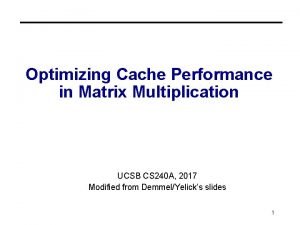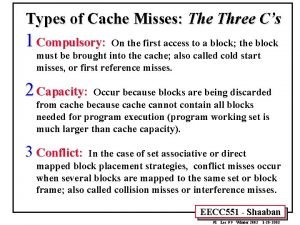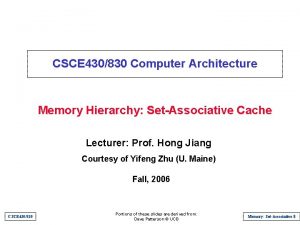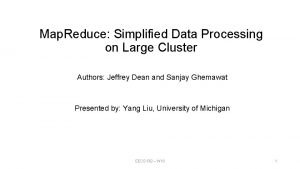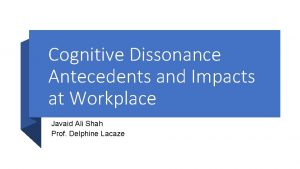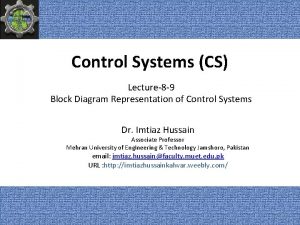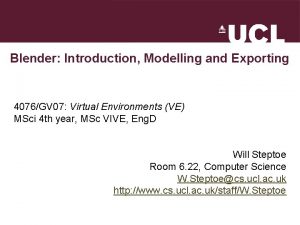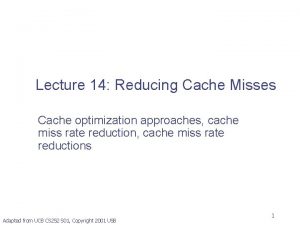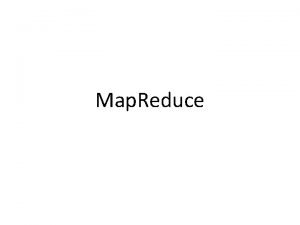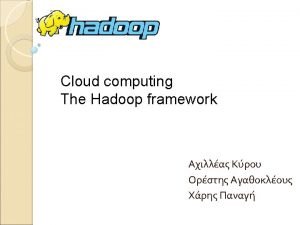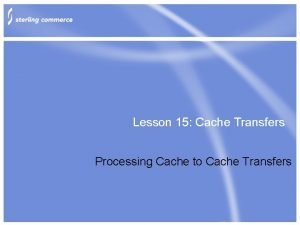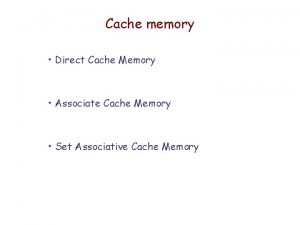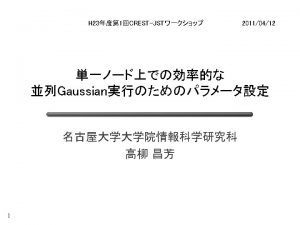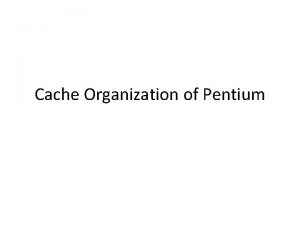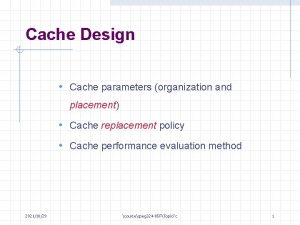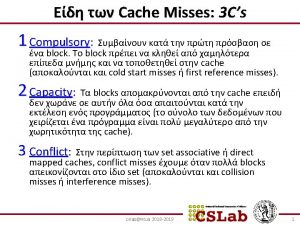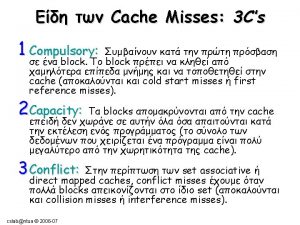Lecture 13 Reduce Cache Miss Rates Cache optimization





















- Slides: 21

Lecture 13: Reduce Cache Miss Rates Cache optimization approaches, cache miss classification, Adapted from UCB CS 252 S 01 1

What Is Memory Hierarchy A typical memory hierarchy today: Proc/Regs Bigger L 1 -Cache L 2 -Cache Faster L 3 -Cache (optional) Memory Disk, Tape, etc. Here we focus on L 1/L 2/L 3 caches and main memory 2

Why Memory Hierarchy? CPU “Moore’s Law” 100 10 1 µProc 60%/yr. Processor-Memory Performance Gap: (grows 50% / year) DRAM 7%/yr. 1980 1981 1982 1983 1984 1985 1986 1987 1988 1989 1990 1991 1992 1993 1994 1995 1996 1997 1998 1999 2000 Performance 1000 1980: no cache in µproc; 1995 2 -level cache on chip (1989 first Intel µproc with a cache on chip) 3

Generations of Microprocessors Time of a full cache miss in instructions executed: 1 st Alpha: 340 ns/5. 0 ns = 68 clks x 2 or 136 2 nd Alpha: 266 ns/3. 3 ns = 80 clks x 4 or 320 3 rd Alpha: 180 ns/1. 7 ns =108 clks x 6 or 648 1/2 X latency x 3 X clock rate x 3 X Instr/clock 4. 5 X 4

Area Costs of Caches Processor % Area %Transistors ( cost) ( power) Intel 80386 0% 0% Alpha 21164 37% 77% Strong. Arm SA 110 61% 94% Pentium Pro 64% 88% n 2 dies per package: Proc/I$/D$ + L 2$ Itanium 92% Caches store redundant data only to close performance gap 5

What Is Exactly Cache? Small, fast storage used to improve average access time to slow memory; usually made by SRAM Exploits locality: spatial and temporal In computer architecture, almost everything is a cache! n n n n Register file is the fastest place to cache variables First-level cache a cache on second-level cache Second-level cache a cache on memory Memory a cache on disk (virtual memory) TLB a cache on page table Branch-prediction a cache on prediction information? Branch-target buffer can be implemented as cache Beyond architecture: file cache, browser cache, proxy cache Here we focus on L 1 and L 2 caches (L 3 optional) as buffers to main memory 6

Example: 1 KB Direct Mapped Cache Assume a cache of 2 N bytes, 2 K blocks, block size of 2 M bytes; N = M+K (#block times block size) n (32 - N)-bit cache tag, K-bit cache index, and M-bit cache The cache stores tag, data, and valid bit for each block n n Stored as part of the cache “state” Cache Tag Cache Data Byte 31 Byte 63 : Valid Bit Ex: 0 x 00 Ex: 0 x 01 0 x 50 : : 31 Cache index is used to select a block in SRAM (Recall BHT, BTB) Block tag is compared with the input tag Block address 9 4 0 A word. Tagin the data block selected as Block theoffset output Example: 0 x 50 may be Index Byte 1 Byte 33 Byte 0 Byte 32 0 1 2 3 : : Byte 1023 : n Byte 992 31 7

For Questions About Cache Design Block placement: Where can a block be placed? Block identification: How to find a block in the cache? Block replacement: If a new block is to be fetched, which of existing blocks to replace? (if there are multiple choice) Write policy: What happens on a write? 8

Where Can A Block Be Placed What is a block: divide memory space into blocks as cache is divided n A memory block is the basic unit to be cached Direct mapped cache: there is only one place in the cache to buffer a given memory block N-way set associative cache: N places for a given memory block n n Like N direct mapped caches operating in parallel Reducing miss rates with increased complexity, cache access time, and power consumption Fully associative cache: a memory block can be put anywhere in the cache 9

Set Associative Cache Example: Two-way set associative cache n Cache index selects a set of two blocks n The two tags in the set are compared to the input in parallel n Data is selected based on the tag comparison Set associative or direct mapped? Discuss later Valid Cache Tag : : Adr Tag Compare Cache Index Cache Data Cache Block 0 : : Sel 1 1 Mux 0 Sel 0 Cache Tag Valid : : Compare OR Hit Cache Block 10

How to Find a Cached Block Direct mapped cache: the stored tag for the cache block matches the input tag Fully associative cache: any of the stored N tags matches the input tag Set associative cache: any of the stored K tags for the cache set matches the input tag Cache hit latency is decided by both tag comparison and data access 11

Which Block to Replace? Direct mapped cache: Not an issue For set associative or fully associative* cache: n n n Random: Select candidate blocks randomly from the cache set LRU (Least Recently Used): Replace the block that has been unused for the longest time FIFO (First In, First Out): Replace the oldest block Usually LRU performs the best, but hard (and expensive) to implement *Think fully associative cache as a set associative one with a single set 12

What Happens on Writes Where to write the data if the block is found in cache? Write through: new data is written to both the cache block and the lower-level memory n Help to maintain cache consistency Write back: new data is written only to the cache block n Lower-level memory is updated when the block is replaced n A dirty bit is used to indicate the necessity n Help to reduce memory traffic What happens if the block is not found in cache? Write allocate: Fetch the block into cache, then write the data (usually combined with write back) No-write allocate: Do not fetch the block into cache (usually combined with write through) 13

Real Example: Alpha 21264 Caches 64 KB 2 -way associative instruction cache 64 KB 2 -way associative data cache I-cache D-cache 14

Alpha 21264 Data Cache D-cache: 64 K 2 -way associative Use 48 -bit virtual address to index cache, use tag from physical address 48 -bit Virtual=>44 -bit address 512 block (9 -bit blk index) Cache block size 64 bytes (6 -bit offset)t Tag has 44 -(9+6)=29 bits Writeback and write allocated (We will study virtualphysical address translation) 15

Cache performance Calculate average memory access time (AMAT) n Example: hit time = 1 cycle, miss time = 100 cycle, miss rate = 4%, than AMAT = 1+100*4% = 5 Calculate cache impact on processor performance n Note cycles spent on cache hit is usually counted into execution cycles If clock cycle is identical, better AMAT means better performance 16

Example: Evaluating Split Inst/Data Cache Unified vs Split Inst/data cache (Harvard Architecture) Proc Unified Cache-1 I-Cache-1 Unified Cache-2 Proc D-Cache-1 Unified Cache-2 Example on page 406/407 n n n Assume 36% data ops 74% accesses from instructions (1. 0/1. 36) 16 KB I&D: Inst miss rate=0. 4%, data miss rate=11. 4%, overall 3. 24% 32 KB unified: Aggregate miss rate=3. 18% Which design is better? hit time=1, miss time=100 n Note that data hit has 1 stall for unified cache (only one port) AMATHarvard=74%x(1+0. 4%x 100)+26%x(1+11. 4%x 100) = 4. 24 AMATUnified=74%x(1+3. 18%x 100)+26%x(1+1+3. 18%x 100)= 4. 44 n 17

Disadvantage of Set Associative Cach Compare n-way set associative with direct mapped cache: n Has n comparators vs. 1 comparator n Has Extra MUX delay for the data n Data comes after hit/miss decision and set selection In a direct mapped cache, cache block is available before hit/miss decision n Use the data assuming the access is a hit, recover if found otherwise Cache Index Valid Cache Tag Cache Data Cache Block 0 Cache Tag Valid : : : Adr Tag Compare Sel 1 1 Mux 0 Sel 0 Compare OR Hit Cache Block 18

Example: Evaluating Set Associative Cache Suppose a processor with n 1 GHz speed, Ideal (no misses) CPI = 2. 0 n 1. 5 memory references per instruction Two cache organization alternatives n Direct mapped, 1. 4% miss rate, hit time 1 cycle, miss penalty 75 ns n 2 -way set associative, 1. 0% miss rate, increase cycle time by 1. 25 x, hit time 1 cycle, miss penalty 75 ns Performance evaluation by AMAT n Direct mapped: 1. 0 + (0. 014 x 75) = 2. 05 ns n 2 -way set associative: 1. 0 x 1. 25 + (0. 10 x 75) = 2. 00 ns Performance evaluation by CPU time n CPU Time 1 = IC x (2 x 1. 0 + (1. 5 x 0. 014 x 75) = 3. 58 IC n CPU Time 2 = IC x (2 x 1. 0 x 1. 25 + 1. 5 x 0. 010 x 75)=3. 63 IC Better AMAT does not indicate better CPI time, since nonmemory instructions are penalized 19

Evaluating Cache Performance for Outof-order Processors Recall AMAT = hit time + miss rate x miss penalty Very difficult to define miss penalty to fit in this simple model, in the context of OOO processors n n Consider overlapping between computation and memory accesses Consider overlapping among memory accesses for more than one misses We may assume a certain percentage of overlapping n n In practice, the degree of overlapping varies significantly between There are techniques to increase the overlapping, making the cache performance even unpredictable Cache hit time can also be overlapped n The increase of CPI is usually not counted in memory stall time 20

Simple Example Consider an OOO processors into the previous example (slide 18) n Slow clock (1. 25 x base cycle time) n Direct mapped cache n Overlapping degree of 30% Average miss penalty = 70% * 75 ns = 52. 5 ns AMAT = 1. 0 x 1. 25 + (0. 014 x 52. 5) = 1. 99 ns CPU time = ICx(2 x 1. 0 x 1. 25+(1. 5 x 0. 014 x 52. 5))=3. 60 x. IC Compare: 3. 58 for in-order + direct mapped, 3. 63 for inorder + two-way associative This is only a simplified example; ideal CPI could be improved by OOO execution 21
 Ratio guided notes
Ratio guided notes Ratios rates and unit rates
Ratios rates and unit rates Ratios rates and unit rates
Ratios rates and unit rates Ratios rates and unit rates
Ratios rates and unit rates Matrix multiplication cache optimization
Matrix multiplication cache optimization Cache miss types
Cache miss types Cache vs memory
Cache vs memory Miss penalty della cache
Miss penalty della cache 01:640:244 lecture notes - lecture 15: plat, idah, farad
01:640:244 lecture notes - lecture 15: plat, idah, farad Sanjay ghemawat
Sanjay ghemawat How we can reduce water pollution
How we can reduce water pollution How to reduce cognitive dissonance in the workplace
How to reduce cognitive dissonance in the workplace Tujuan teknologi ramah lingkungan
Tujuan teknologi ramah lingkungan Block diagram representation
Block diagram representation Map reduce program
Map reduce program Redox reduction
Redox reduction Objectives of reduce, reuse, recycle
Objectives of reduce, reuse, recycle Blender reduce vertices
Blender reduce vertices How to reduce sulfur dioxide
How to reduce sulfur dioxide Oracle advanced compression
Oracle advanced compression Policies to reduce unemployment
Policies to reduce unemployment Sherpamap
Sherpamap




